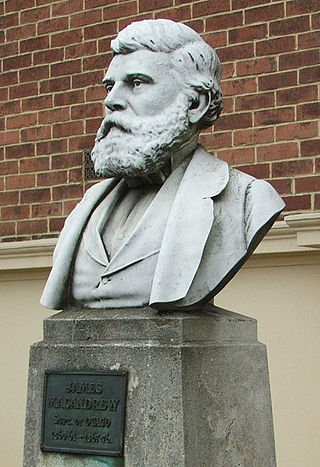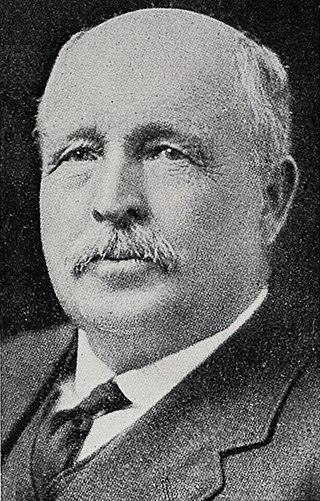Related Research Articles

James Macandrew was a New Zealand ship-owner and politician. He served as a Member of Parliament from 1853 to 1887 and as the last Superintendent of Otago Province.
John Cathcart Wason, generally known as Cathcart Wason, was a Scottish farmer and politician who served as a Member of Parliament in two countries: first in New Zealand and then in Scotland. He established Barrhill, a model village, and after the failure of this colonial venture, he returned to Scotland. An unusually large man, he is noted both as an innovative farmer and for having passed his time in the British House of Commons by knitting.
Stamford was a constituency in the county of Lincolnshire of the House of Commons for the Parliament of England to 1706 then of the Parliament of Great Britain from 1707 to 1800 and of the Parliament of the United Kingdom from 1801 to 1918. It was represented by two Members of Parliament until 1868 when this was reduced to one.

Thomas Bannatyne Gillies was a 19th-century New Zealand lawyer, judge and politician.
Clutha was a New Zealand parliamentary electorate from 1866 to 1996.
Bruce was a rural parliamentary electorate in the Otago region of New Zealand, from 1861 to 1922. For part of the 1860s with the influx to Otago of gold-miners it was a multi-member constituency with two members.
Taieri is a parliamentary electorate in the Otago region of New Zealand, initially from 1866 to 1911, and was later recreated during the 2019/20 electoral redistribution ahead of the 2020 election.

John Edie was a Liberal Party Member of Parliament in the Otago region of New Zealand. He was a surveyor and an engineer, and also spent time as a farmer. He was Mayor of Lawrence.
James William Thomson was a 19th-century conservative Member of Parliament in New Zealand.
Wakanui was a rural parliamentary electorate in the south Canterbury region of New Zealand, from 1881 to 1887.
Wellington, was a parliamentary electorate in Wellington, New Zealand. It existed from 1853 to 1905 with a break in the 1880s. It was a multi-member electorate. The electorate was represented, over the years, by 24 members of parliament.
Members of the New South Wales Legislative Assembly who served in the 11th parliament of New South Wales held their seats from 1882 to 1885. Elections for the eleventh Legislative Assembly were held between 30 November and 21 December 1882 with parliament first meeting on 3 January 1883. The Assembly was expanded to 113 members elected in 40 single member electorates, 26 two member electorates, 3 three member electorate and 3 four member electorates. The parliament had a maximum term of 3 years and was dissolved on 7 October 1885 after 33 months. The Premiers during this parliament were Sir Alexander Stuart until 7 October 1885 and then George Dibbs. The Speaker was Edmund Barton.
William Archibald Murray was a 19th-century Member of Parliament in Otago, New Zealand. During his time in parliament, he moved to the Waikato.
Samuel Locke was a 19th-century Member of Parliament from the Gisborne Region of New Zealand.
Two 1885 by-elections were held in the electorate of Tauranga to replace the sitting member in 1885, during the term of the 9th Parliament.
The Bruce by-election 1862 was a by-election held in the multi-member Bruce electorate during the 3rd New Zealand Parliament, on 31 July 1862. The by-election was caused by the death of incumbent MP Charles Kettle on 5 June, and was won by Edward Cargill.
The April 1865 Bruce by-election was a New Zealand by-election held in the multi-member electorate of Bruce during the 3rd New Zealand Parliament on 8 April 1865. It was triggered on 9 January that year by the resignation of separationist Thomas Gillies and won by prominent settler Arthur John Burns. The more liberal businessman William John Dyer was the sole other contester of the by-election, finishing with 43.33% of the vote.
The July 1865 Bruce by-election was a New Zealand by-election held in the electorate of Bruce during the 3rd New Zealand Parliament on 27 July 1865 triggered by the resignation of Edward Cargill. Three candidates were nominated but one of them withdrew during the nomination meeting. James Macandrew was the successful candidate; he defeated John Cargill, a former Member of Parliament and a brother of the incumbent.
Scot Free was a British Thoroughbred racehorse and sire. He showed promise as a two-year-old in 1883 when he won Sapling Plate. In the following spring he emerged as one of the best horses of his generation in England with emphatic victories in the Craven Stakes and the 2000 Guineas. He had never been entered in the Epsom Derby and finished unplaced when made favourite for the St Leger. He remained in training as a four-year-old in 1885 but became very difficult to manage and was eventually gelded.
The 1883 Bruce by-election was a by-election held on 29 June in the Bruce electorate during the 8th New Zealand Parliament.
References
- ↑ "The Oamaru Mail". Vol. X, no. 3007. 3 August 1885. p. 2. Retrieved 30 April 2020– via Papers Past.
- ↑ "Bruce Election". Clutha Leader. 31 July 1885 – via Papers Past.
- ↑ "Random Notes". Clutha Leader. 14 August 1885 – via Papers Past.
- ↑ "Random Notes". Clutha Leader. 21 August 1885 – via Papers Past.
- ↑ "Bruce Election". Otago Daily Times . 6 August 1885.